Articles
- Page Path
- HOME > J Korean Acad Nurs > Volume 45(5); 2015 > Article
-
Original Article
- Factors Influencing Changes in Quality of Life in Patients undergoing Hematopoietic Stem Cell Transplantation: A Longitudinal and Multilevel Analysis
- Chi Eun Song, Hyang Sook So
-
Journal of Korean Academy of Nursing 2015;45(5):694-703.
DOI: https://doi.org/10.4040/jkan.2015.45.5.694
Published online: October 30, 2015
1Chonnam National University Hwasun Hospital, Chonnam, Korea.
2College of Nursing, Chonnam National University, Gwangju, Korea.
- Address reprint requests to: So, Hyang Sook. College of Nursing, Chonnam National University, 160 Baekseo-ro, Dong-gu, Gwangju 61469, Korea. Tel: +82-62-530-4952, Fax: +82-62-227-4009, hsso0075@chonnam.ac.kr
© 2015 Korean Society of Nursing Science
This is an Open Access article distributed under the terms of the Creative Commons Attribution NoDerivs License. (http://creativecommons.org/licenses/by-nd/4.0/) If the original work is properly cited and retained without any modification or reproduction, it can be used and re-distributed in any format and medium.
Abstract
-
Purpose
- This study was a prospective longitudinal study to identify changes in quality of life in patients undergoing allogeneic hematopoietic stem cell transplantation (HSCT). It was based on Roy's adaptation model.
-
Methods
- The questionnaires were administered before HSCT, 30 and 100 days after HSCT. Of the 48 potentially eligible patients, 44 (91.7%) participated in the study and 40 (90.9%) completed the questionnaires at 100 days after HSCT. Multilevel analysis was applied to analyze changes in quality of life.
-
Results
- Overall, quality of life showed a decreasing tendency from pre-HSCT to 100 days after HSCT. The adaptation level of participants was compensatory. Type of conditioning was the significant factor influencing quality of life before HSCT (β00=79.92, p <.001; β01= - 12.64, p <.001) and the change rate of quality of life (β10= - 1.66, p =.020; β11=2.88, p =.014). Symptom severity (β20= - 1.81, p =.004), depression (β30= - 0.58, p =.001), social dependency (β40= - 0.35, p =.165), and loneliness (β50= - 0.23, p =.065) had a negative effect on changes in quality of life. Symptom severity and depression were statistically significant factors influencing changes in quality of life.
-
Conclusion
- According to the results of this study, the development of nursing intervention is needed to improve quality of life in patients undergoing allogeneic hematopoietic stem cell transplantation in the early immune reconstruction period. The interventions should include programs to enhance coping capacity and programs to help control symptom severity and depression. Also these interventions need to be started from the beginning of HSCT and a multidisciplinary approach would be helpful.
This article is based on a part of the first author's doctoral thesis from Chonnam National University.
- 1. Gratwohl A, Baldomero H. Trends of hematopoietic stem cell transplantation in the third millennium. Curr Opin Hematol. 2009;16(6):420–426. ArticlePubMed
- 2. Pidala J, Anasetti C, Jim H. Health-related quality of life following haematopoietic cell transplantation: Patient education, evaluation and intervention. Br J Haematol. 2010;148(3):373–385. ArticlePubMed
- 3. Cohen MZ, Rozmus CL, Mendoza TR, Padhye NS, Neumann J, Gning I, et al. Symptoms and quality of life in diverse patients undergoing hematopoietic stem cell transplantation. J Pain Symptom Manage. 2012;44(2):168–180. ArticlePubMedPMC
- 4. Andersson I, Ahlberg K, Stockelberg D, Brune M, Persson LO. Health-related quality of life in patients undergoing allogeneic stem cell transplantation after reduced intensity conditioning versus myeloablative conditioning. Cancer Nurs. 2009;32(4):325–334. ArticlePubMed
- 5. Bevans MF, Marden S, Leidy NK, Soeken K, Cusack G, Rivera P, et al. Health-related quality of life in patients receiving reducedintensity conditioning allogeneic hematopoietic stem cell transplantation. Bone Marrow Transplant. 2006;38(2):101–109. ArticlePubMedPDF
- 6. Tomblyn M, Chiller T, Einsele H, Gress R, Sepkowitz K, Storek J, et al. Guidelines for preventing infectious complications among hematopoietic cell transplantation recipients: A global perspective. Biol Blood Marrow Transplant. 2009;15(10):1143–1238. ArticlePubMedPMC
- 7. Grant M, Cooke L, Williams AC, Bhatia S, Popplewell L, Uman G, et al. Functional status and health-related quality of life among allogeneic transplant patients at hospital discharge: A comparison of sociodemographic, disease, and treatment characteristics. Support Care Cancer. 2012;20(11):2697–2704. ArticlePubMedPMCPDF
- 8. Braamse AM, Gerrits MM, van Meijel B, Visser O, van Oppen P, Boenink AD, et al. Predictors of health-related quality of life in patients treated with auto- and allo-SCT for hematological malignancies. Bone Marrow Transplant. 2012;47(6):757–769. ArticlePubMedPDF
- 9. Roy C. The Roy Adaptation Model. 3rd ed. Upper Saddle River, NJ: Pearson; 2009.
- 10. Shin JH. Application of repeated-measures analysis of variance and hierarchical linear model in nursing research. Nurs Res. 2009;58(3):211–217. ArticlePubMed
- 11. Jung M, Lee H. Predictors of quality of life following HSCT recipients. J Korean Acad Adult Nurs. 2008;20(2):341–352.
- 12. Cleeland CS, Mendoza TR, Wang XS, Chou C, Harle MT, Morrissey M, et al. Assessing symptom distress in cancer patients: The M.D. Anderson symptom inventory. Cancer. 2000;89(7):1634–1646.ArticlePubMed
- 13. Sung HM, Kim JB, Park YN, Bai DS, Lee SH, Ahn HN. A study on the reliability and the validity of Korean version of the Beck Depression Inventory-II (BDI-II). J Korean Soc Biol Ther Psychiatry. 2008;14(2):201–212.
- 14. McCorkle R, Benoliel JQ, Donaldson G, Georgiadou F, Moinpour C, Goodell B. A randomized clinical trial of home nursing care for lung cancer patients. Cancer. 1989;64(6):1375–1382.ArticlePubMed
- 15. Kim KH, Kim JH. Korea UCLA loneliness scale. J Stud Guid. 1989;16:13–30.
- 16. Barone SH, Roy CL, Frederickson KC. Instruments used in Roy Adaptation Model-based research: Review, critique, and future directions. Nurs Sci Q. 2008;21(4):353–362. ArticlePubMedPDF
- 17. Nuamah IF, Cooley ME, Fawcett J, McCorkle R. Testing a theory for health-related quality of life in cancer patients: A structural equation approach. Res Nurs Health. 1999;22(3):231–242.ArticlePubMed
- 18. Ferrans CE, Powers MJ. Quality of life index: Development and psychometric properties. ANS Adv Nurs Sci. 1985;8(1):15–24.PubMed
- 19. Baker F, Curbow B, Wingard JR. Development of the satisfaction with life domains scale for cancer. J Psychosoc Oncol. 1993;10(3):75–90. Article
- 20. Beck AT, Steer RA, Brown GK. Manual for the Beck Depression Inventory-II. San Antonio, TX: Psychological Corporation; 1996.
- 21. Russell D, Peplau LA, Cutrona CE. The revised UCLA loneliness scale: Concurrent and discriminant validity evidence. J Pers Soc Psychol. 1980;39(3):472–480.ArticlePubMed
- 22. Baker F, Denniston M, Hann D, Gesme D, Reding DJ, Flynn T, et al. Factor structure and concurrent validity of the Satisfaction with Life Domains Scale for cancer (SLDS-C). J Psychosoc Oncol. 2007;25(2):1–17.Article
- 23. Peugh JL. A practical guide to multilevel modeling. J Sch Psychol. 2010;48(1):85–112. Article
- 24. Hong SH, Park EH, Hong HY. Estimating adolescent's hanges in self-concept Tests of the effects of parents and peers on individual differences in the changes. Stud Korean Youth. 2006;17(2):241–263.
- 25. Sprangers MA, Schwartz CE. Integrating response shift into health-related quality of life research: A theoretical model. Soc Sci Med. 1999;48(11):1507–1515.ArticlePubMed
- 26. Bevans M. Health-related quality of life following allogeneic hematopoietic stem cell transplantation. Hematology Am Soc Hematol Educ Program. 2010;2010:248–254. ArticlePDF
- 27. Syrjala KL, Langer SL, Abrams JR, Storer B, Sanders JE, Flowers ME, et al. Recovery and long-term function after hematopoietic cell transplantation for leukemia or lymphoma. JAMA. 2004;291(19):2335–2343. Article
- 28. Lee SJ, Loberiza FR, Antin JH, Kirkpatrick T, Prokop L, Alyea EP, et al. Routine screening for psychosocial distress following hematopoietic stem cell transplantation. Bone Marrow Transplant. 2005;35(1):77–83. ArticlePubMedPDF
- 29. Jarden M, Baadsgaard MT, Hovgaard DJ, Boesen E, Adamsen L. A randomized trial on the effect of a multimodal intervention on physical capacity, functional performance and quality of life in adult patients undergoing allogeneic SCT. Bone Marrow Transplant. 2009;43(9):725–737. ArticlePubMedPDF
- 30. Grulke N, Albani C, Bailer H. Quality of life in patients before and after haematopoietic stem cell transplantation measured with the European Organization for Research and Treatment of Cancer (EORTC) quality of life core questionnaire QLQ-C30. Bone Marrow Transplantation. 2012;47(4):473–482. ArticlePDF
REFERENCES
Figure & Data
REFERENCES
Citations

- Estimating the Incidence-Based Cost of Illness Due to Hematopoietic Stem Cell Transplantation Using One-Year Insurance Claim Data in Korea
Sol Kwon, Hye-Young Kang
PharmacoEconomics - Open.2023; 7(2): 189. CrossRef - Determining the symptoms and coping methods of patients at home after hematopoietic stem cell transplantation
Kader Caliskan, Gulbeyaz Can
Supportive Care in Cancer.2022; 30(7): 5881. CrossRef - Effect of Acculturative Stress on Multicultural Adolescents’ Life Satisfaction: Sequential Multiple Mediating Effects of Bicultural Acceptance Attitude, Self-Esteem, and Social Withdrawal -Using the 2016 Multicultural Adolescents Panel Study-
Soo Mi Kim, Hyeon Ok Kim
Journal of Korean Academy of Nursing.2022; 52(3): 324. CrossRef - Changes in Fatigue, Psychological Distress, and Quality of Life After Chemotherapy in Women with Breast Cancer
Pok-Ja Oh, Jung-Ran Cho
Cancer Nursing.2020; 43(1): E54. CrossRef - Experiences of Unrelated Hematopoietic Stem-cell Donors and Experts of Relevant Institutions
Soyoung Yu, Miok Kim, Tai-Gyu Kim, Su-Hee Beom
Korean Journal of Adult Nursing.2019; 31(5): 522. CrossRef - Factors Influencing Health Related Quality of Life in Adult Survivors of Haematopoietic Stem Cell Transplantation
Hyunjin Kwon, Eunjung Ryu
Asian Oncology Nursing.2017; 17(4): 220. CrossRef - The Symptom Management of Myeloproliferative Neoplasms
晓婧 李
Advances in Clinical Medicine.2017; 07(02): 59. CrossRef - A Multilevel Analysis of the Effect of Individual and Family Personalities on Depressive Symptoms in Families with College Students
김석선, 길민지
Health and Social Welfare Review.2016; 36(3): 34. CrossRef - Evaluation of Quality of Life and Care Needs of Turkish Patients Undergoing Hematopoietic Stem Cell Transplantation
Neslisah Yasar, Semiha Akin
Nursing Research and Practice.2016; 2016: 1. CrossRef
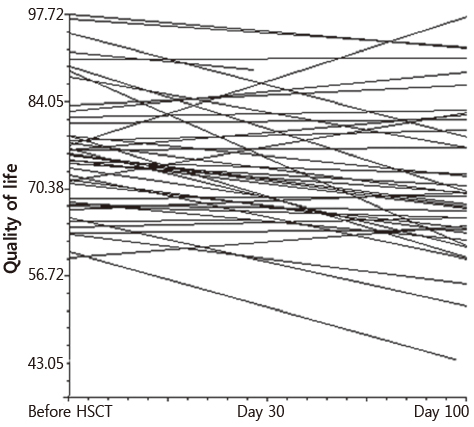
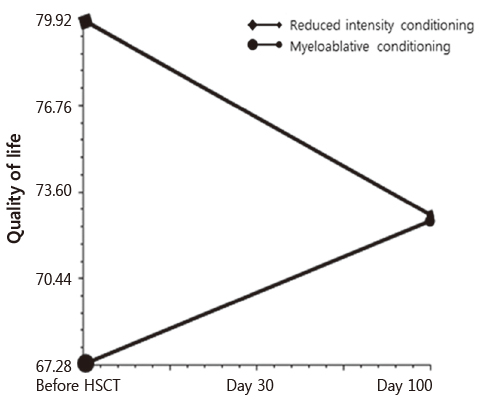
Figure 1
Figure 2
Demographic and Clinical Characteristics of Participants (N =43)
Mean Score of Research Variables at Study Time Points
HSCT=Hematopoietic stem cell transplantation.
The Effects of Symptom Severity, Depression, Social Dependency, and Loneliness on Changes in Quality of Life (N =43)
*MAC=Myeloablative conditioning, dummy variable; Reference group=Reduced intensity conditioning.
HSCT=Hematopoietic stem cell transplantation.
*MAC=Myeloablative conditioning, dummy variable; Reference group=Reduced intensity conditioning.
 KSNS
KSNS
 E-SUBMISSION
E-SUBMISSION


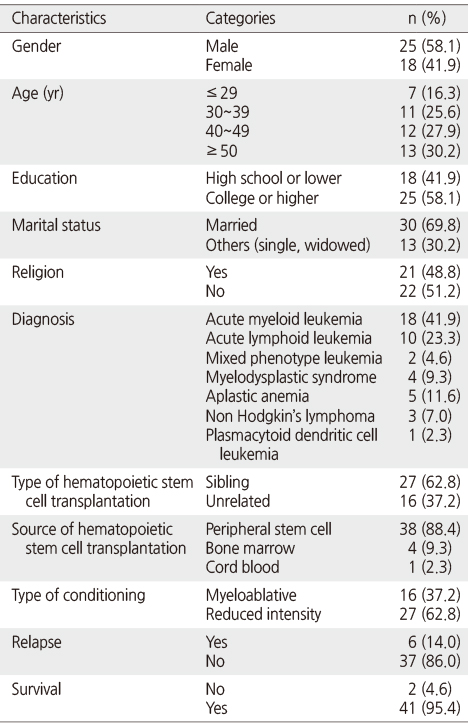
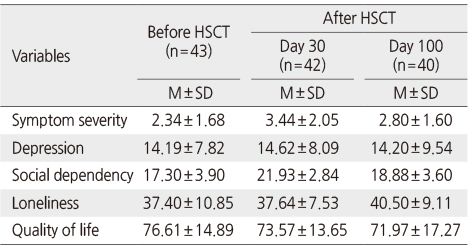
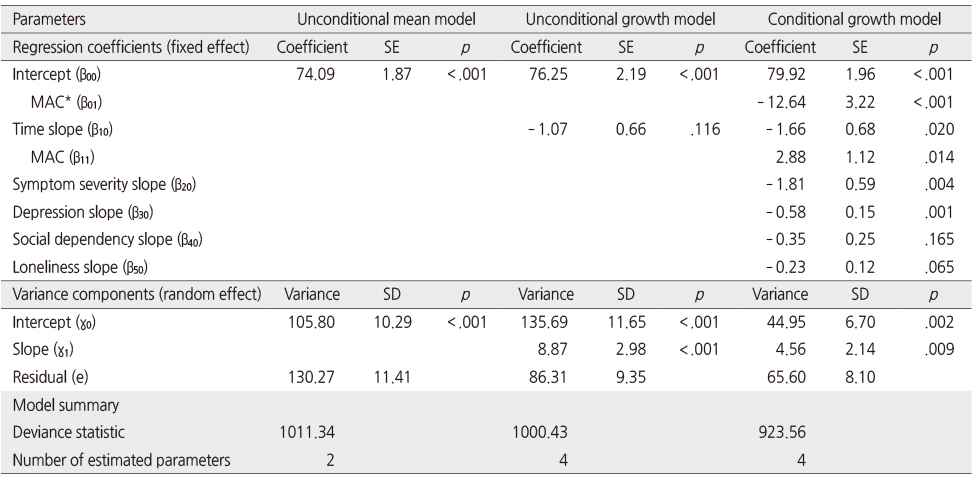
 Cite
Cite

